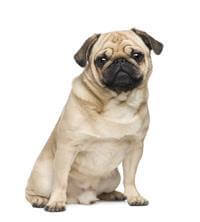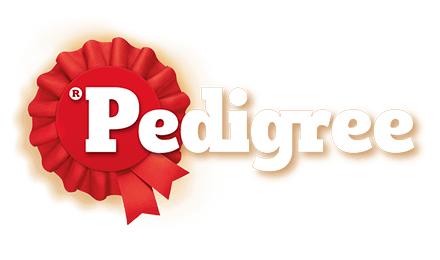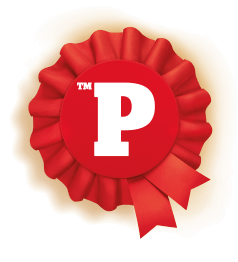Find products that match your dog’s needs

Pugs are one of the world's most beloved dog breeds, and it's easy to see why. These small dogs are famous for their playful personalities, expressive faces, and endless charm. Known for their cuddly nature, Pugs are the perfect fit for those seeking a small, affectionate lap dog. They're a fantastic choice for first-time pet owners and adapt well to apartment living. To discover more about this endearing dog breed, please continue reading.
Keep these factors in mind before you bring a Pug dog home:
Weight | 6 to 8 kg |
Height | 10 to 13 inches |
Lifespan | 13 to 15 years |
Coat | Double coat |
Note: The weight and height mentioned on the table is of a full-grown Pug and not of a Pug puppy.
Pugs have a short, smooth coat. Their coats are also glossy and often come in two standard colours:
A true purebred Pug won't have markings other than the possible sable pattern in fawn varieties. You'll also notice equally distributed fur and strong, straight legs. Keep these characteristics in mind when considering a purebred Pug:
Note: Their ears come in two types: 'rose' ears fold back slightly, while 'button' ears are set higher on the head.
Pugs are renowned for their friendly and cheerful personalities. They thrive on companionship and adore being by their owner's side. Whether it's curling up on your lap while you work or snuggling beside you on the couch, Pugs crave attention. However, this doesn't mean they're high maintenance.
It's important to note that Pugs can become sad or lonely if left alone for extended periods. They're best suited for homes where someone is present for a good portion of the day. While not bred for strenuous activities like hunting or guarding, Pugs enjoy playtime! Opt for games that don't require excessive exertion, keeping their playful nature entertained.
Gentle and patient, Pugs are wonderful dogs for both children and seniors. They don't bark excessively but will alert you to something unusual. When not playing or receiving cuddles, Pugs are happy to spend their time napping – a testament to their easy-going nature.
Pugs are typically obedient and eager to please, making them responsive to training. Positive reinforcement methods – like using dog treats or praise – are highly effective. Opt to integrate training into their everyday life, using a portion of dog treats as rewards for desired behaviours.
Harsh training techniques are counterproductive with Pugs. They may shut down or refuse to cooperate if scolded or handled roughly. Early socialisation is also essential. Introducing your Pug puppy to new people, sights, and sounds builds confidence and helps them navigate the world with ease.
Here’s all you need to know when preparing to look after a Pug:
Pugs are adorable dogs, but it's important to be aware that their unique features can come with some health concerns. Their flat faces (called brachycephaly) can make breathing harder, especially in hot weather, so avoid intense exercise then. Their large eyes are prone to issues like ulcers and dryness, so regular vet checks are a must. Skin problems can also occur, so watch for unusual signs and talk to your vet. Pugs may sometimes experience joint problems, allergies, and in rare cases, a serious neurological disease called Pug Dog Encephalitis (PDE). If you have any concerns about your Pug's health, always consult your veterinarian.
Pugs are relatively low-maintenance when it comes to grooming, but they do shed, so some regular care is needed. Brush them at least once a week to remove loose hair and keep their coat healthy. Bathe your Pug about once a month with gentle dog shampoo (more often if they get extra dirty) using lukewarm water. Pay special attention to those adorable facial wrinkles by wiping them daily with a damp cloth to prevent irritation, especially after meals. Keep their nails trimmed for comfort, and brush their teeth daily with dog-specific toothpaste for good oral health.
Pugs are delightful dogs, but their energy needs are moderate compared to many other dog breeds. Aim for around an hour of daily physical activity. This could include a couple of short walks in the morning and evening when the weather is milder. Remember, due to their flat faces, Pugs are sensitive to heat, so avoid strenuous exercise during the hottest parts of the day. Mental stimulation is just as important! Provide puzzle toys or games to keep your Pug challenged and engaged. This helps prevent boredom and promotes healthy mental well-being.
Two nutritionally balanced meals a day are ideal for most Pugs. Consulting with your veterinarian is the best way to determine the appropriate amounts and food type based on your dog's age, activity level, and overall health. While those big puppy-dog eyes can be persuasive, it's important to be mindful of dog treats. Pugs are prone to weight gain, so treats should be given sparingly. To avoid health issues and begging, it's best to stick to designated mealtimes and avoid feeding table scraps.
The Pug boasts an impressive lineage, ranking among the oldest dog breeds globally. Their roots can be traced back to 400 B.C. China, where flat-faced canines were prized dogs of emperors and rulers.
Throughout history, these charming dogs have been known by various names, including Lo-sze, Mopsi, and Doguillo. Their popularity extended beyond China's borders, with Pugs becoming treasured gifts for esteemed foreign visitors.
In the 16th and early 17th centuries, Dutch traders introduced the Pug to Europe, where they quickly captivated hearts. The Victorian era saw a surge in Pug popularity, with their adorable visages gracing postcards, paintings, and even figurines.
An interesting historical footnote: In 1860, when British forces occupied the Chinese Imperial Palace, they discovered a significant number of Pugs. These Pugs were brought back to England and played a role in further refinement of the breed.
Yes, pugs are generally friendly with other pets like cats and dogs when properly socialised. Early introduction and supervision can create a peaceful multi-pet household.
Pugs can be wonderful family dogs. They're playful, affectionate, and adaptable to various living situations.
Pugs may not do well alone for extended periods. Consider crate training and providing stimulating toys to manage short separations.
Pug grooming is relatively simple. Weekly brushing and occasional baths help manage shedding. Regular cleaning of their facial wrinkles is important.
Pugs are not known for excessive barking. They may alert you to unfamiliar sights or sounds, but are generally quiet dogs.

Find a PEDIGREE® stockist
near you!
Buy online
Click to buy from any of the retailers below

